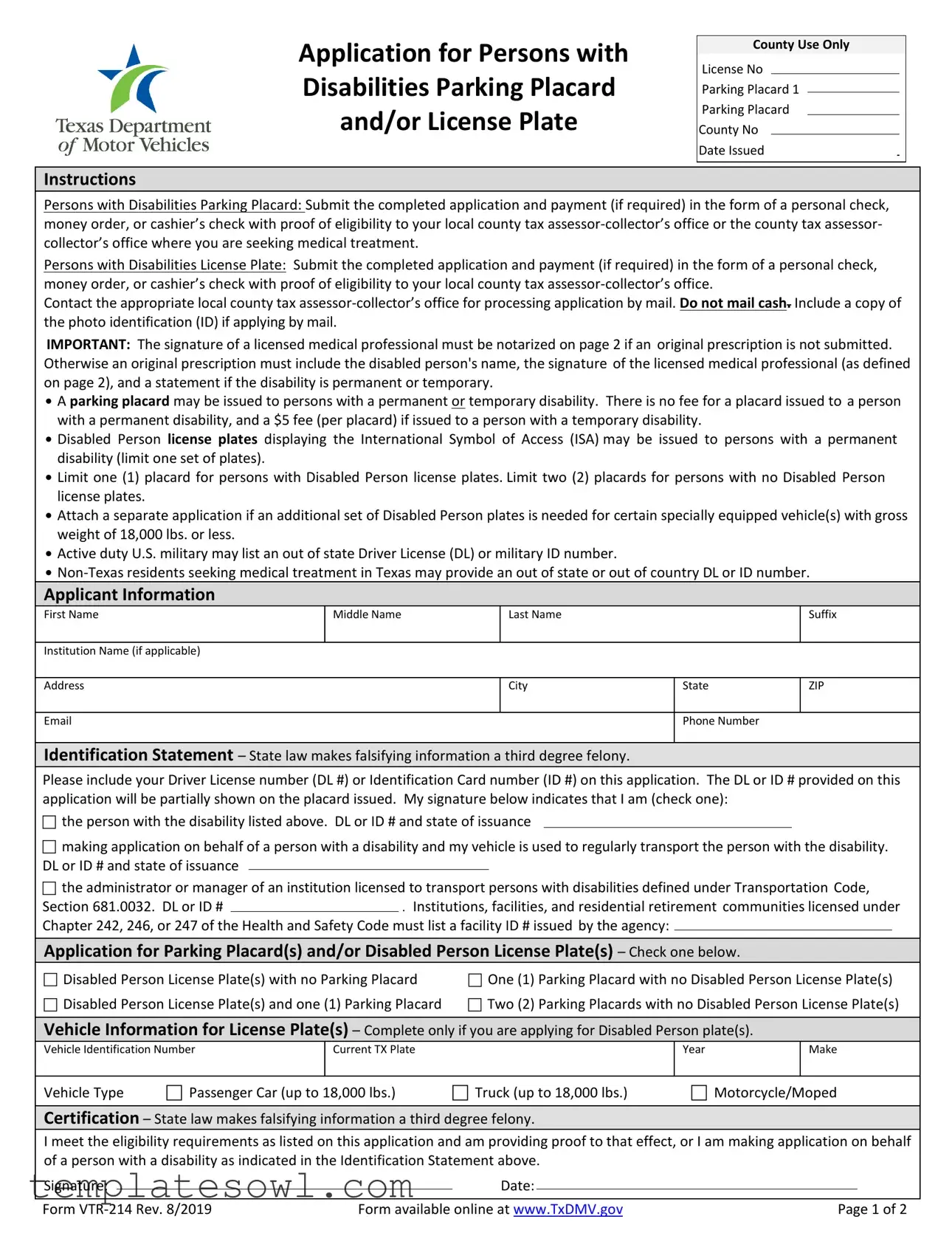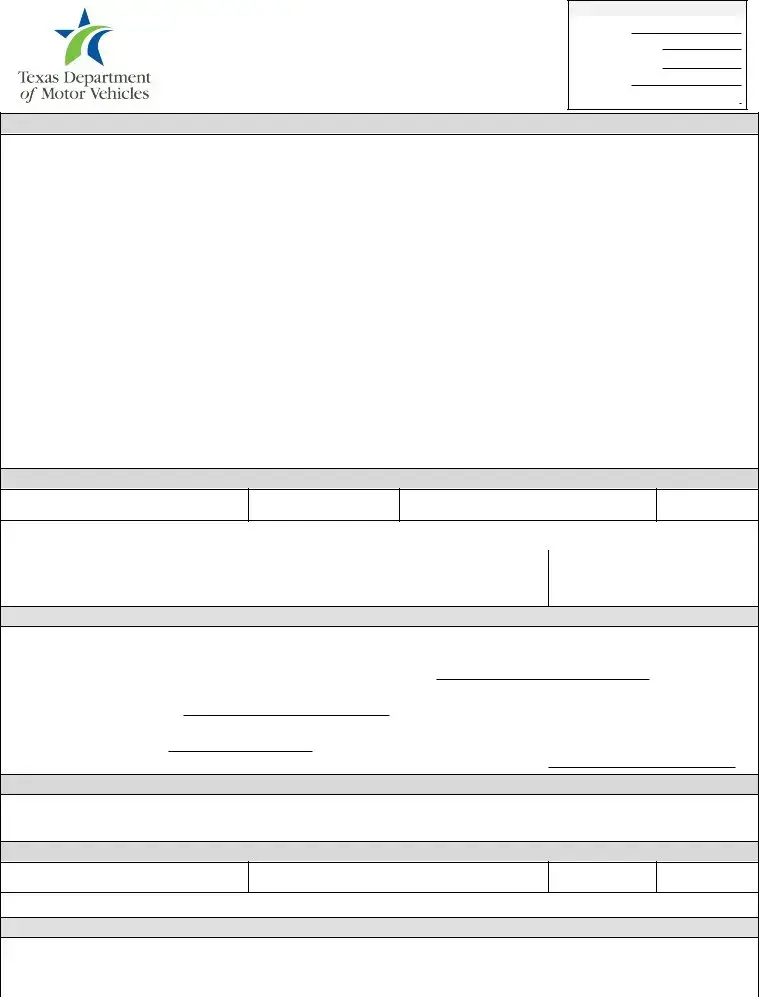Application for Persons with Disabilities Parking Placard and/or License Plate
County Use Only
License No
Parking Placard 1
Parking Placard
County No
Date Issued
Instructions
Persons with Disabilities Parking Placard: Submit the completed application and payment (if required) in the form of a personal check, money order, or cashier’s check with proof of eligibility to your local county tax assessor-collector’s office or the county tax assessor- collector’s office where you are seeking medical treatment.
Persons with Disabilities License Plate: Submit the completed application and payment (if required) in the form of a personal check, money order, or cashier’s check with proof of eligibility to your local county tax assessor-collector’s office.
Contact the appropriate local county tax assessor-collector’s office for processing application by mail. Do not mail cash. Include a copy of the photo identification (ID) if applying by mail.
IMPORTANT: The signature of a licensed medical professional must be notarized on page 2 if an original prescription is not submitted. Otherwise an original prescription must include the disabled person's name, the signature of the licensed medical professional (as defined on page 2), and a statement if the disability is permanent or temporary.
•A parking placard may be issued to persons with a permanent or temporary disability. There is no fee for a placard issued to a person with a permanent disability, and a $5 fee (per placard) if issued to a person with a temporary disability.
•Disabled Person license plates displaying the International Symbol of Access (ISA) may be issued to persons with a permanent disability (limit one set of plates).
•Limit one (1) placard for persons with Disabled Person license plates. Limit two (2) placards for persons with no Disabled Person license plates.
•Attach a separate application if an additional set of Disabled Person plates is needed for certain specially equipped vehicle(s) with gross weight of 18,000 lbs. or less.
•Active duty U.S. military may list an out of state Driver License (DL) or military ID number.
•Non-Texas residents seeking medical treatment in Texas may provide an out of state or out of country DL or ID number.
Applicant Information
Institution Name (if applicable)
Address |
City |
State |
ZIP |
|
|
|
|
Email |
|
Phone Number |
|
Identification Statement – State law makes falsifying information a third degree felony.
Please include your Driver License number (DL #) or Identification Card number (ID #) on this application. The DL or ID # provided on this application will be partially shown on the placard issued. My signature below indicates that I am (check one):
the person with the disability listed above. DL or ID # and state of issuance
making application on behalf of a person with a disability and my vehicle is used to regularly transport the person with the disability. DL or ID # and state of issuance
the administrator or manager of an institution licensed to transport persons with disabilities defined under Transportation Code,
Section 681.0032. DL or ID #. Institutions, facilities, and residential retirement communities licensed under Chapter 242, 246, or 247 of the Health and Safety Code must list a facility ID # issued by the agency:
Application for Parking Placard(s) and/or Disabled Person License Plate(s) – Check one below.
Disabled Person License Plate(s) with no Parking Placard |
One (1) Parking Placard with no Disabled Person License Plate(s) |
Disabled Person License Plate(s) and one (1) Parking Placard Two (2) Parking Placards with no Disabled Person License Plate(s) Vehicle Information for License Plate(s) – Complete only if you are applying for Disabled Person plate(s).
Vehicle Identification Number
Vehicle Type |
Passenger Car (up to 18,000 lbs.) |
Truck (up to 18,000 lbs.) |
Motorcycle/Moped |
Certification – State law makes falsifying information a third degree felony.
I meet the eligibility requirements as listed on this application and am providing proof to that effect, or I am making application on behalf of a person with a disability as indicated in the Identification Statement above.
Signature: |
|
|
Date: |
|
|
|
|
|
|
|
|
|
|
|
|
|
|
|
Form VTR-214 Rev. 8/2019 |
Form available online at www.TxDMV.gov |
Page 1 of 2 |
Application for Persons with Disabilities Parking Placard and/or License Plate
Definitions
Transportation Code, Section 681.001(2) defines a disability as a condition in which a person has:
(a)mobility problems that substantially impair the person's ability to ambulate;
(b)visual acuity of 20/200 or less in the better eye with correcting lenses; or
(c)visual acuity of more than 20/200 but with a limited field of vision in which the widest diameter of the visual field subtends an angle of 20 degrees or less.
Transportation Code, Section 681.001(5) defines a mobility problem as one that substantially impairs a person's ability to ambulate, and the person:
(a)cannot walk 200 feet without stopping to rest;
(b)cannot walk without the use of or assistance from an assistance device, including a brace, cane, crutch, another person or a prosthetic device;
(c)cannot ambulate without a wheelchair or similardevice;
(d)is restricted by lung disease to the extent that the person's forced respiratory expiratory volume for one second, measured by spirometry, is less than one liter, or the arterial oxygen tension is less than 60 millimeters of mercury on room air at rest;
(e)uses portable oxygen;
(f)has a cardiac condition to the extent that the person's functional limitations are classified in severity as Class III or Class IV according to standards set by the American Heart Association;
(g)is severely limited in the ability to walk because of an arthritic, neurological, or orthopedic condition;
(h)has a disorder of the foot that, in the opinion of a physician licensed to practice medicine in this state or in a state adjacent to this state, limits or impairs the person's ability to walk; or
(i)has another debilitating condition that, in the opinion of a physician licensed to practice medicine in this state or a state adjacent to this state, or authorized by applicable law to practice medicine in a hospital or other health facility of the Veterans Administration, limits or impairs the person's ability to walk.
Disability Statement – This section to be completed by a Licensed Medical Professional.*
*A Licensed Medical Professional is defined as a physician, podiatrist, optometrist, or qualifying physician's assistant or advanced practice nurse as defined in Chapter 301, Occupations Code. At least one of the following conditions must be met:
•Licensed in Texas, Arkansas, Louisiana, New Mexico, or Oklahoma; or
•Must practice medicine in a U.S. military installation based in Texas;or
•Must practice medicine in a hospital or health facility of the U.S. Department of Veterans Affairs.
|
|
|
|
|
|
I certify that |
|
|
has a permanent, or temporary disability as defined above. |
|
Printed Name of Person with a Disability or Mobility Problem |
|
|
|
|
|
|
|
Printed Name of Licensed Medical Professional |
|
Professional License Number |
Date |
|
|
|
|
|
|
Signature of Licensed Medical Professional |
|
|
|
|
|
|
|
|
|
Mailing Address |
City |
State |
ZIP |
Notary – This section must be completed by a notary if an original prescription is not submitted.
On this date, |
the above named licensed medical professional |
|
Date |
|
Name |
appeared before me so that I could witness his or her signature.
State of, County of
|
S T A M P |
Notary Public |
|
H E R E |
|
|
|
|
My commission expires |
|
|
Date |
Form VTR-214 Rev. 8/2019 |
Form available online at www.TxDMV.gov |
Page 2 of 2 |


